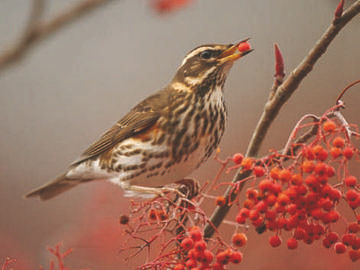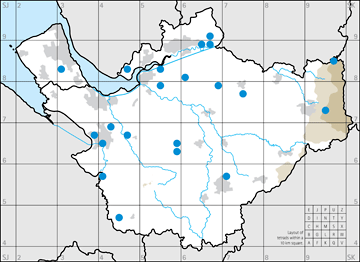Redwing (Turdus iliacus)

Redwing © Steve Round

Redwing roost map.
This is our most widespread winter visitor, being found in 603 tetrads. The map suggests that they avoid some urban and industrial areas: the east Wirral conurbation, Stanlow, Runcorn/ Widnes, Chester and Northwich, and there was none on Hilbre or the highest hills. Redwings come here for the winter from two different breeding areas, with the birds sufficiently distinct to form two races: coburni from Iceland are slightly larger, with more distinct breast markings and legs dark brown rather than the pink of iliacus birds from Fennoscandia and Russia. A bird ringed at Norton Priory, Runcorn (SJ58L) in January was caught by a ringer in Arkhangelsk, Russia, near the Arctic Circle 2750 km away. Most coburni winter in Ireland, but ringing has shown that some visit Cheshire and Wirral.
As with all wintering thrushes, their preferred diet is soil invertebrates, especially earthworms, but they eat a wide variety of fruits, and in hard weather will eat nothing else. In many tetrads, Redwings were found on bare ground, including newly ploughed or harrowed fields, or stubble, even maize stubble which often has few other birds; fields recently covered with slurry or manure seemed almost guaranteed to attract Redwings. Several observers commented on their liking for horse paddocks and fields with livestock, sheep or cattle. Fruit-eating birds were noted on holly, ivy, hawthorn and rowan. They were often found in mixed flocks with Fieldfares, and the two species’ habitat preferences are very similar. Redwings were mostly reported in farmland (71% of habitat records), mainly mostly improved grassland (29%) and tall hedges (18%), and 8% in human sites. Especially in hard weather, Redwings enter woodland and forage amongst the leaf litter, and broadleaved or mixed woodland provided 15% of the habitat records.
Most surveyors counted their Redwings, providing 828 counts over the three years of the Atlas survey. There were eleven records of large flocks of 500 or more, headed by the 1000 reported by Roy and Iona Bowden near Delamere (SJ57L). Numbers can vary greatly from one year to another, figures submitted for this Atlas showing as many birds counted in 2004/ 05 as in the other two winters combined, from similar numbers of tetrads each year; the median flock sizes were 52, 29 and 31 in the three winters. This variation reflects the species’ nomadic nature, few birds showing any site fidelity from one winter to another: one ringed at Norton Priory, Runcorn, was in Spain for the next winter, and others have been found in France and Italy. Coward (1910) noted the fluctuation in numbers, and Redwings’ susceptibility to hard weather, hard frost or heavy snow driving most birds from the county or into close proximity to man in suburban gardens’ berry-bearing bushes. Bell (1962) concentrated on their migration dates, and gave no indication of the species’ winter distribution or numbers.
This is one of the few species for which several observers reported roosts, in a variety of sites including rhododendrons under mature trees, phragmites and willows, and holding a variety of numbers of birds, from ten to 300. The excitement of seeing, and hearing, several hundreds of these birds entering a communal roost provides a satisfying end to fieldwork on a winter evening, and it would be good to know more about their night-time haunts: after all, in midwinter Redwings, like all passerines, spend twice as much time in their nocturnal roost as in daytime feeding.
Sponsored by Margaret Bain, Barry Taylor and Stephen Taylor

